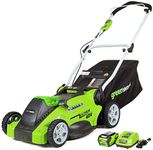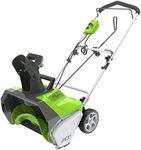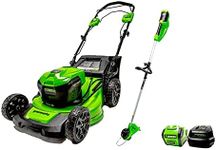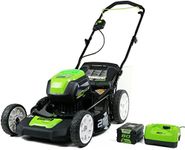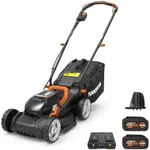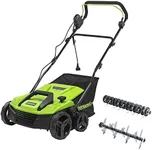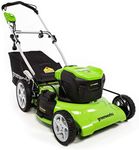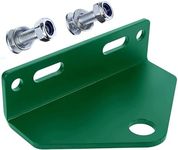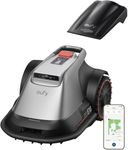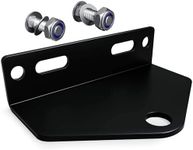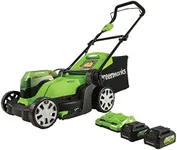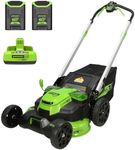Buying Guide for the Best Greenworks Mowers
Choosing the right lawn mower can make yard work much easier and more enjoyable. When shopping for a mower, it's important to think about the size and type of your lawn, how much effort you want to put into mowing, and any special features that might make the job easier for you. Understanding the key specifications will help you find a mower that fits your needs and makes lawn care more efficient.Cutting WidthCutting width refers to how wide a strip of grass the mower can cut in a single pass. This is important because a wider cutting width means you can mow your lawn faster, as you'll need fewer passes to cover the same area. Cutting widths are usually divided into small (under 16 inches), medium (16-20 inches), and large (over 20 inches). If you have a small or narrow yard with lots of obstacles, a smaller cutting width can help you maneuver more easily. For larger, open lawns, a wider cutting width will save you time.
Power SourceThe power source tells you how the mower is powered—either by a battery, corded electricity, or gas. Battery-powered mowers are quiet and easy to start, but their run time is limited by battery life. Corded electric mowers offer unlimited run time but require you to manage a power cord, which can be tricky in larger yards. Gas mowers are powerful and can run as long as you have fuel, but they are louder and require more maintenance. Choose a power source based on your yard size, your tolerance for noise and maintenance, and whether you have easy access to power outlets.
Cutting Height AdjustmentCutting height adjustment lets you change how short or tall the mower cuts your grass. This is important because different grass types and seasons may require different mowing heights for healthy growth. Mowers usually offer a range of height settings, from low (about 1 inch) to high (over 3 inches). If you want flexibility to adjust for different conditions, look for a mower with easy-to-use height adjustment and a wide range of settings.
Grass Handling OptionsGrass handling options refer to how the mower deals with the clippings. The main options are bagging (collecting clippings in a bag), mulching (chopping clippings finely and returning them to the lawn), and side discharge (ejecting clippings to the side). Some mowers offer all three, while others may only offer one or two. If you want a tidy lawn with no clippings left behind, bagging is best. If you want to naturally fertilize your lawn, mulching is a good choice. Side discharge is useful for quickly mowing large areas where clippings can be left on the ground.
Weight and ManeuverabilityWeight and maneuverability describe how easy the mower is to push and turn. Lighter mowers are easier to handle, especially in small or uneven yards, while heavier mowers may be more stable on slopes. Some mowers have self-propelled features that help move the mower forward, making them easier to use on larger or hilly lawns. Consider your own strength and the layout of your yard when deciding how much weight and maneuverability you need.
Battery Life and Charging Time (for Battery Models)For battery-powered mowers, battery life tells you how long the mower can run on a single charge, and charging time tells you how long it takes to recharge. Longer battery life is important for larger lawns, so you can finish mowing without stopping to recharge. Charging time matters if you want to mow more than once in a day or if you forget to charge in advance. If you have a small yard, shorter battery life may be fine, but for bigger spaces, look for longer run times or consider buying an extra battery.
